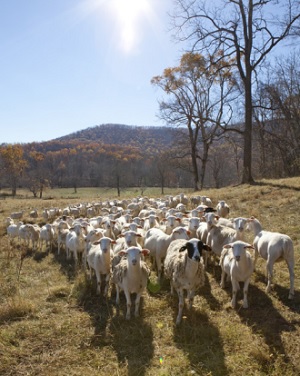The Benefits of Rotational Grazing
Like many Piedmont farms, Over Jordan Farm in Rappahannock has been a pasture-based operation for decades. After 20 years of overgrazing, however, it’s facing issues that are common in the region—poor soil health, a lack of grass and plant diversity and the resulting lack of nutrients for livestock. This not only decreases a farm’s profitability, but it’s also a major source of runoff and soil erosion in VA.
Due to the environmental and economic impacts of overgrazing, it’s an important issue for agricultural and conservation groups. But changing an agricultural operation can seem risky to farmers, and some are wary of trying new pasture management practices.
Walking the walk

In response to these issues, PEC and our partners are embarking on a new exciting project that’s funded by a grant from the USDA Natural Resource Conservation Service. PEC, the Pasture-Based Enterprise Network and the Virginia Cooperative Extension are working with Michael Sands—the manager of Over Jordan Farm—to create a place where livestock producers can come see and evaluate different management practices and their effects on livestock health, weight gain, and soil and pasture health.
The overgrazed pastures of Over Jordan Farm are perfect for testing the effects of rotational and multi-species grazing—two techniques shown to improve the health of the land and livestock. Sands—who has over 30 years of experience in sustainable agriculture, environmental conservation and community-based economic development—will manage a combination of cows and sheep on 110 acres of the farm. He plans to graze them on multiple fields with different management objectives, including native grasses for summer grazing, stockpiled fescue for winter strip-grazing, and improved and unimproved mixed grass pastures. Measurements taken over a three year period will gauge any changes in livestock health, soil health and fertility, as well as plant and wildlife diversity.
Seeing another farmer’s experience can make trying something new less intimidating, so this project will also have a heavy focus on outreach. Through a variety of peer-to-peer meetings, field days at the farm, and focus group sessions—regional farmers will be able to see firsthand the effects Sands’ management practices have over time.
“The goal is to make money farming and improve the environment at the same time—not to see those as conflicting goals,” says Sands. “I’m excited! We don’t have all of the answers, so this will provide an opportunity for farmers to learn with us as we go.”
This article was featured in our Winter 2013 Member Newsletter, The Piedmont View.
